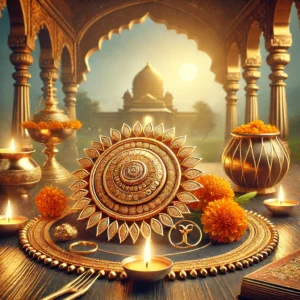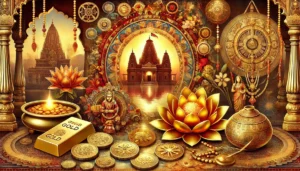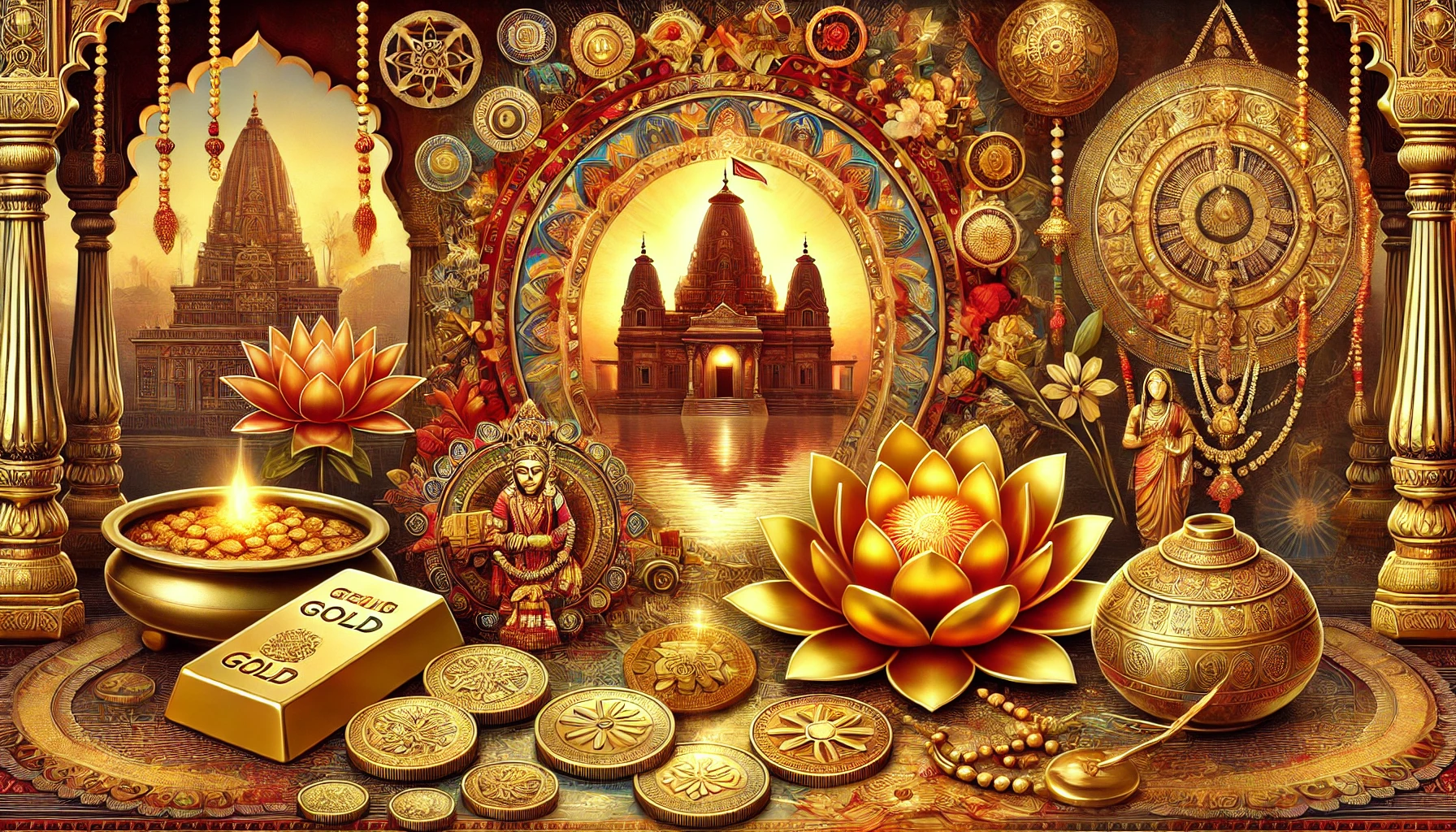
Gold in Sanatan Dharma mythology
Understanding Gold’s Cultural and Financial Significance in Sanatan Dharma
Gold has been a symbol of divine prosperity, spiritual purity, and financial stability in Sanatan Dharma, or Hinduism, for millennia. Its gleaming presence transcends the material realm, reflecting the eternal and auspicious qualities cherished in Hindu philosophy. Gold’s role spans religious rituals, mythological narratives, and economic practices, making it an indispensable part of the Sanatan tradition.
Cultural Significance of Gold in Sanatan Dharma
- A Symbol of Purity and Divinity
In Hinduism, gold symbolizes purity, immortality, and divine blessings. It is believed to possess a sacred energy that never diminishes, much like the eternal soul (atman). Gold is often equated with the radiant energy of Surya, the Sun God, who represents vitality, illumination, and life. Its unblemished brilliance is seen as a reflection of the divine order in the cosmos.
- Integral Role in Religious Ceremonies
Gold plays a prominent role in Hindu religious practices. Temples across India are adorned with gold-plated domes and idols of deities often covered in gold ornaments. This practice signifies the offering of wealth to the divine and an acknowledgment of the deity’s supreme power.
During pujas, gold coins, ornaments, or even small gold replicas of deities are offered to symbolize devotion and gratitude.
Festivals like Akshaya Tritiya, Dhanteras, and Diwali are marked by the purchase and gifting of gold, signifying wealth accumulation and divine blessings for prosperity.
In South Indian traditions, prominent temples like the Tirupati Balaji and Padmanabhaswamy Temple house vast reserves of gold as offerings from devotees, highlighting gold’s association with spiritual wealth and devotion.
- Gold as a Sacred Gift
In Sanatan Dharma, gold is a medium of blessings. When gifted during life events such as weddings, child births, or housewarming ceremonies, it is not merely a gesture of goodwill but a symbolic act of bestowing prosperity, protection, and eternal blessings. Bridal gold jewelry is deeply symbolic, representing the blessings of a harmonious and prosperous married life.
- Mythological Significance
Hindu scriptures and epics, such as the Ramayana and Mahabharata, often depict gold as a symbol of divine wealth and virtue. The golden city of Lanka, ruled by Ravana, represents material opulence, while the legendary tales of Lord Kubera, the treasurer of the gods, portray gold as a divine and inexhaustible treasure.
Gold is also associated with celestial events, such as the descent of the Ganges from heaven, which is likened to the shining purity of molten gold, reinforcing its spiritual and mythological prominence.

Gold in Sanatan Dharma mythology
Table of Contents
Financial Significance of Gold in Sanatan Dharma
- A Timeless Store of Value
From ancient times, gold has been viewed as a reliable store of value, immune to the ravages of time and inflation. Hindu scriptures often advise individuals to accumulate gold not only as a mark of prosperity but also as a hedge against uncertainties. This practical approach to wealth is embedded in the dharmic understanding of artha (material wealth).
- Medium of Exchange and Currency
In ancient India, gold coins such as suvarna and dinara were widely used as currency. These coins facilitated trade and were a measure of an individual’s or kingdom’s wealth. Even today, gold is considered a liquid asset, reinforcing its role as a financial cornerstone.
- Intergenerational Wealth Transfer
Gold holds a unique place in Hindu family traditions as an asset passed down through generations. This practice is not only a means of preserving wealth but also a way of carrying forward blessings and ancestral heritage. Gold ornaments, often inherited, carry emotional and cultural significance, linking the past, present, and future.
- Auspicious Timing for Acquisition
The purchase of gold is deeply entwined with astrological and religious beliefs. Days like Akshaya Tritiya are celebrated as ideal for investing in gold, as it is believed that such acquisitions bring unending prosperity. This tradition aligns material wealth accumulation with cosmic and spiritual forces, emphasizing harmony between the physical and metaphysical realms.

Gold in Sanatan Dharma mythology
Gold in the Context of Dharma, Artha, and Moksha
Sanatan Dharma teaches a balanced approach to life, encompassing the four purusharthas (human goals): Dharma (righteousness), Artha (wealth), Kama (desires), and Moksha (liberation). Gold plays a significant role in achieving this balance:
Dharma (Righteousness): Gold offerings in temples and rituals represent adherence to dharma, reflecting gratitude and devotion to the divine.
Artha (Wealth): Gold serves as a tangible form of wealth, ensuring financial security and stability.
Kama (Desires): Adorning oneself with gold fulfills aesthetic and societal desires while maintaining cultural identity.
Moksha (Liberation): Gold’s unchanging nature symbolizes the eternal soul, inspiring individuals to pursue spiritual wisdom while managing material responsibilities.
Modern-Day Relevance of Gold in Sanatan Dharma
While the world has witnessed significant economic and cultural changes, gold continues to retain its central role in Hindu traditions. Beyond its use in religious ceremonies, gold is increasingly seen as a strategic financial investment. Many Hindu families invest in gold-backed assets such as ETFs, coins, or bars, ensuring their financial stability while maintaining cultural and spiritual connections.
The enduring appeal of gold lies in its ability to serve as a bridge between tradition and modernity, material wealth and spiritual values. Its presence in Hindu households, temples, and festivals highlights its unmatched significance in both practical and symbolic terms.
Conclusion
Gold’s cultural and financial significance in Sanatan Dharma is a testament to its timeless appeal. Revered as a divine metal, it embodies purity, prosperity, and eternal blessings. Its dual role as a spiritual symbol and financial asset underscores the dharmic balance between material pursuits and spiritual goals.
In the journey of life, gold stands as a guiding light, reminding individuals of the eternal connection between the earthly and the divine. Whether in rituals, heirlooms, or investments, gold remains a cherished treasure in Sanatan Dharma, carrying the promise of prosperity, continuity, and spiritual harmony.

Gold in Sanatan Dharma mythology
FAQs on “Gold in Sanatan Dharma: Exploring Its Cultural and Financial Essence”
- Why is gold considered sacred in Sanatan Dharma?
In Sanatan Dharma, gold is regarded as a symbol of divine energy, purity, and immortality. It reflects the radiance of the sun and represents a connection with the eternal cosmic cycle, making it sacred in Hindu philosophy.
- What role does gold play in Hindu rituals and ceremonies?
Gold plays a central role in Hindu traditions. From being offered to deities during poojas to adorning idols with gold ornaments, it signifies reverence and devotion. It is also exchanged in weddings and other ceremonies as a symbol of blessings and stability.
- How does gold feature in ancient Hindu scriptures?
Hindu scriptures like the Vedas, Puranas, and Mahabharata mention gold as a divine material. For instance, the Rigveda describes gold as a symbol of splendor and vitality, while the Bhagavad Gita mentions its role in rituals.
- Is there any spiritual significance of gold in Sanatan Dharma?
Spiritually, gold is believed to have a high vibration and is thought to attract positive energy. It is considered a medium for connecting with divine forces, balancing energy fields, and promoting mental clarity and focus.
- Why is gold associated with Goddess Lakshmi and wealth?
Gold is deeply connected with Goddess Lakshmi, the deity of wealth, prosperity, and abundance. Gold ornaments and coins are often used in prayers to invoke her blessings and signify material and spiritual richness.
- How does gold symbolize financial security in Sanatan Dharma?
Traditionally, gold has been a safeguard against financial uncertainties. Its enduring value ensures security, making it a preferred form of inheritance and wealth preservation across generations.
- Why is gold given as a gift during auspicious occasions?
Gold symbolizes eternal prosperity and goodwill. During weddings, festivals, or milestones, gifting gold is a way to wish recipients long-lasting happiness, financial stability, and divine blessings.
- What are some festivals where gold plays a significant role in Sanatan Dharma?
Akshaya Tritiya: Considered an auspicious day to buy gold, symbolizing eternal prosperity.
Dhanteras: Gold purchases mark the beginning of Diwali and are seen as an act of inviting wealth into the home.
Diwali: Gold is exchanged and worn to celebrate abundance and good fortune.
- How does gold contribute to the social and economic fabric of Hindu society?
Gold is both a personal and communal asset in Hindu culture. It enhances social bonds through traditions like gifting and dowries and serves as an economic buffer during financial crises, playing a role in the cultural and economic well-being of families.
- Does wearing gold have traditional health benefits?
According to Ayurvedic practices, gold is believed to strengthen immunity, enhance energy flow, and stabilize emotions. Wearing gold close to the skin, especially in the form of jewelry, is thought to promote overall well-being.
- What significance does gold have in Hindu temples?
Hindu temples are often adorned with gold as a mark of devotion and opulence. Gold donations to temples signify gratitude to the divine and help in maintaining the sanctity and prosperity of the temple.
- What is the historical importance of gold in Sanatan Dharma?
Gold has been revered since ancient times in Sanatan Dharma. Kings used gold for religious offerings, constructing temples, and crafting intricate ornaments. Gold coins and jewelry were considered symbols of prosperity and divine favor.
- Why is gold considered an eternal investment in Hindu culture?
Gold’s intrinsic value, durability, and cultural reverence make it a timeless asset. Its ability to retain and grow in value over time ensures wealth preservation, aligning with the Sanatan Dharma philosophy of securing future generations.
- What are the astrological connections of gold in Sanatan Dharma?
Gold is linked to the planet Jupiter (Guru), which represents knowledge, wisdom, and prosperity in Vedic astrology. Wearing gold is believed to strengthen Jupiter’s influence, bringing success, wealth, and positivity.
- How is gold viewed as a symbol of marital harmony?
In Hindu weddings, gold jewelry is a significant part of the bride’s adornments, symbolizing her new journey and financial security. It is also seen as a token of marital harmony and familial unity.
- What are the rituals associated with gold during childbirth?
Gold is often used in rituals after childbirth, such as gifting gold ornaments to the newborn or engraving the child’s name on a gold plate. It signifies blessings, health, and a prosperous life.
- How has gold influenced the art and craft traditions in Hindu culture?
Gold has inspired intricate craftsmanship in Hindu culture, evident in temple architecture, deity ornaments, and traditional jewelry designs. It showcases artistic excellence while embodying spiritual and cultural values.
- What is the role of gold in funeral and afterlife beliefs in Sanatan Dharma?
Gold is sometimes placed with the deceased during cremation or burial as a symbol of wealth and spiritual purity. It is believed to aid the soul’s journey toward liberation (moksha).
- Why is gold considered auspicious during business ventures?
In Hindu culture, initiating business ventures with gold, such as buying gold coins or ornaments, is believed to attract prosperity, success, and divine blessings.
- How does the modern relevance of gold align with its traditional values?
While gold continues to be a financial asset, its cultural significance remains unchanged. It bridges tradition and modernity by serving both spiritual and economic purposes in contemporary Hindu society.
Summary
Gold in Sanatan Dharma: Exploring Its Cultural and Financial Essence
Gold has long held a unique place in human civilization, serving as a symbol of wealth, power, and divinity. In the context of Sanatan Dharma, the significance of gold transcends its material value, deeply intertwining with cultural, spiritual, and financial aspects of life. This article delves into the multifaceted role of gold in the Sanatan tradition, highlighting its enduring importance across history.
Cultural and Spiritual Significance
In Sanatan Dharma, gold is revered as a sacred metal associated with purity, prosperity, and divine blessings. It symbolizes Goddess Lakshmi, the deity of wealth and abundance, and plays a prominent role in religious rituals, festivals, and ceremonies. For instance, gold ornaments are integral to temple offerings, symbolizing devotion and gratitude to the divine. Similarly, the use of gold in idols, sacred vessels, and jewelry reflects its sanctity in spiritual practices.
Gold also represents the eternal, unchanging nature of the divine. Its untarnished quality is seen as a metaphor for spiritual enlightenment and truth. Furthermore, its incorporation into traditional attire and wedding ceremonies signifies the transmission of wealth, stability, and blessings across generations.
Financial and Social Relevance
Beyond its spiritual value, gold has been a cornerstone of financial security in Sanatan Dharma. In ancient India, gold was a medium of exchange, a store of value, and a symbol of economic stability. Even today, it remains a preferred form of investment, safeguarding against inflation and economic uncertainties. Families often accumulate gold as an asset to ensure long-term financial stability, particularly for significant life events such as marriages or crises.
Gold’s role in social customs is equally significant. In many households, it is considered auspicious to gift gold during festivals like Diwali or occasions like childbirth and weddings, symbolizing goodwill and prosperity. The tradition of passing down gold jewelry and artifacts as heirlooms reinforces its cultural and financial legacy.
Conclusion
Gold’s enduring appeal in Sanatan Dharma stems from its dual role as a spiritual emblem and a financial asset. It bridges the material and the divine, reflecting the philosophy of Sanatan Dharma, which harmonizes the physical and metaphysical realms. By understanding gold’s profound significance, we gain deeper insights into the values, beliefs, and practices that have shaped the Sanatan way of life over millennia.
Related Articles
- Restful Nights: Ayurvedic Remedies and Traditional Indian Practices to Overcome Insomnia and Late-Night Habits
- The Tridevi: Lakshmi, Saraswati, and Parvati – Their Roles and Powers
- “Divine Creatures of Ancient Indian Scriptures: Exploring the Role of Animals in the Vedas, Puranas, and Mahabharata”
- Nature and Spirituality: Exploring the Sacred Essence of the Himalayas, Ganga, and Other Natural Wonders”
- “Reviving the Gurukul System: Relevance and Lessons for Modern Education”
- “Exploring Greek and Indian Mythology: Similarities Between Greek and Indian Mythology “
- “Embracing Sattvic Living: Harmonizing Mind, Body, and Soul Through Food and Lifestyle”
- “Charity and Prosperity: Exploring the Concept of Daan and Its Financial Relevance in Modern Life”
- How to Build an Eco-Friendly Home Inspired by Vastu Shastra
- Comparison of Ancient and Modern Sports: How Traditional Sports Have Influenced Contemporary Games
- “Timeless Lessons from Ancient Tales: Linking Samudra Manthan and Ganga’s Descent to Modern Ecological Challenges”
- “Reviving Sanskrit: How AI is Preserving Ancient Languages for the Future”
- “Mathura: The Sacred Land of Lord Krishna’s Divine Leelas”
- Investing for Future Generations: Lessons from Indian Traditions on Legacy Building and Wealth Preservation
- “Ancient Indian Wisdom: Timeless Lessons for Tackling Today’s Climate Crisis”
- “Artificial Intelligence and Spirituality: Transforming Ancient Practices for the Modern World”
- “Gold and Real Estate in India: Timeless Assets Shaping Financial Strategies”
- Tradition Meets Innovation: The Evolution of Technology in Hindu Rituals
- End-of-World Myths: Exploring Kali Yuga in Hinduism and Ragnarök in Norse Mythology
- Garuda, Pegasus, and Dragons: The Universal Ties of Mythical Beasts Across Cultures
- “Ancient Vimanas: Mythical Flying Machines or Evidence of Advanced Technology?”
- Time Travel in Hindu Mythology: The Fascinating Tales of Kakudmi and King Raivata
- “Divine Feminine Power in Hindu Mythology: The Legends of Durga, Saraswati, and Lakshmi”
- “Divine Beings of Sanatan Dharma: The Spiritual Significance of Sacred Animals in Hinduism”
- “Symbolism in Mythological Art: Unlocking Hidden Meanings in Ancient Temple Carvings”
- “Exploring Technological Advancements in Ancient India and Civilizations: Vimana, Metallurgy, & Water Management systems”
- Unveiling the Mysteries: Ancient Temples of Sanatan Dharma , Mysterious Temples of India
- “The Scientific Knowledge of Sanatan Dharma: Ancient Wisdom Meets Modern Science”
- Ancient Indian Sports and Games: Celebrating a Legacy of Skill, Strength & Strategy”
- “Exploring the Cosmic Link: The Connection Between Astronomy and Vedic Astrology”
- The Power of Sanskrit: Unlocking the Divine Language of the Gods
- “The End of Kaliyuga: A Sanatan Insight into the World’s Final Chapter”
- Explore more articles on Prachin Sanatan Yuga.
Gold in Sanatan Dharma mythology Gold in Sanatan Dharma mythology Gold in Sanatan Dharma mythology Gold in Sanatan Dharma mythology Gold in Sanatan Dharma mythology Gold in Sanatan Dharma mythology Gold in Sanatan Dharma mythology Gold in Sanatan Dharma mythology Gold in Sanatan Dharma mythology Gold in Sanatan Dharma mythology Gold in Sanatan Dharma mythology
Gold in Sanatan Dharma mythology Gold in Sanatan Dharma mythology Gold in Sanatan Dharma mythology Gold in Sanatan Dharma mythology Gold in Sanatan Dharma mythology Gold in Sanatan Dharma mythology Gold in Sanatan Dharma mythology Gold in Sanatan Dharma mythology Gold in Sanatan Dharma mythology Gold in Sanatan Dharma mythology Gold in Sanatan Dharma mythology
Gold in Sanatan Dharma mythology Gold in Sanatan Dharma mythology Gold in Sanatan Dharma mythology Gold in Sanatan Dharma mythology Gold in Sanatan Dharma mythology Gold in Sanatan Dharma mythology Gold in Sanatan Dharma mythology Gold in Sanatan Dharma mythology Gold in Sanatan Dharma mythology Gold in Sanatan Dharma mythology Gold in Sanatan Dharma mythology
